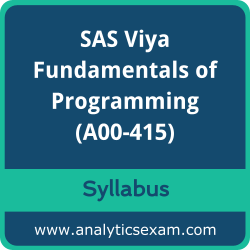 This page is a one-stop solution for any information you may require for SAS Viya Programming Associate (A00-415) Certification exam. The SAS A00-415 Exam Summary, Syllabus Topics and Sample Questions provide the base for the actual SAS Certified Associate - Programming Fundamentals Using SAS Viya exam preparation, we have designed these resources to help you get ready to take your dream exam.
This page is a one-stop solution for any information you may require for SAS Viya Programming Associate (A00-415) Certification exam. The SAS A00-415 Exam Summary, Syllabus Topics and Sample Questions provide the base for the actual SAS Certified Associate - Programming Fundamentals Using SAS Viya exam preparation, we have designed these resources to help you get ready to take your dream exam.
The SAS Viya Programming Associate credential is globally recognized for validating SAS Viya Fundamentals of Programming knowledge. With the SAS Certified Associate - Programming Fundamentals Using SAS Viya Certification credential, you stand out in a crowd and prove that you have the SAS Viya Fundamentals of Programming knowledge to make a difference within your organization. The SAS Viya Programming Associate Certification (A00-415) exam will test the candidate's knowledge on following areas.
SAS A00-415 Exam Summary:
| Exam Name | SAS Viya Programming Associate |
| Exam Code | A00-415 |
| Exam Duration | 95 minutes |
| Exam Questions | 50-55 |
| Passing Score | 68% |
| Exam Price | $120 (USD) |
| Training | Accelerating SAS Code on the SAS Viya Platform |
| Exam Registration | Pearson VUE |
| Sample Questions | SAS Viya Fundamentals of Programming Certification Sample Question |
| Practice Exam | SAS Viya Fundamentals of Programming Certification Practice Exam |
SAS A00-415 Exam Topics:
| Objective | Details |
|---|---|
Programming in SAS Viya Concepts (10-15%) |
|
| Describe the SAS Viya architecture. |
- Compute Server vs. Cloud Analytics Server (CAS) - Serial vs parallel processing - In-memory processing - Open source integration |
| Explain when to use the CAS server for programming tasks. |
- Size of data - Type of SAS procedure used |
Managing Data in CAS (25-30%) |
|
| Explain how to access and use CAS Libraries (caslibs). |
- Establish CAS sessions with the CAS statement. - Caslib attributes (Session, local, active, personal) - Properties of the casuser caslib - Use the CASLIB statement to assign session-scope caslibs - Assign a libref to a caslib with the LIBNAME statement and CAS engine - View the contents of a caslib with PROC CASUTIL |
| Describe how to load data into In-Memory Tables. |
- Load data files into memory - Client-side vs server-side files - Loading client-side data (PROC CASUTIL)
- In-memory table scope (Session vs Global, promoting tables)
- Alternate data loading methods (DATA step, PROC SQL, PROC IMPORT) |
| Describe how to save and drop In-Memory Tables. |
- SASHDAT files - PROC CASUTIL
|
| Describe CAS column data types. |
- Properties of character column variable types
- Properties of numeric column variable types
- Create varchar column variables with the LENGTH statement |
DATA Step and SQL programming in CAS (20-25%) |
|
| Explain how SAS determines where code executes. |
- Location of the input/output data - What procedures are being run - What statements/functions are used - SESSREF= option on the DATA statement - SESSREF= option within FedSQL - MSGLEVEL= system option |
| Explain threading within the SAS DATA step. |
- Where code executes: CAS, Compute Server - Effect of threads on the DATA step - _THREADID_ and _NTHREADS_ automatic variables - SINGLE= DATA step option - Adjust DATA Step code when accumulating totals - Explain how BY groups are processed in CAS enabled DATA step code
|
| Update DATA step code to run in CAS. |
- DESCENDING keyword - WHERE= option - INFILE/INPUT/DATALINES statements - MODIFY/REMOVE/REPLACE statements - DATALIMIT= option - Functions not supported in CAS (Examples: RANBIN, RANUNI, SYMGET, FILEREF, GIT functions) |
| Update PROC SQL code to run as PROC FEDSQL code. |
- Data types - Supported statements - Mnemonics vs operators - SESSREF= option - Remerge - Calculated keyword - SET operations - Correlated subqueries - Dictionary tables - Views - LIMIT clause - FORMAT, LABEL vs PROC CASUTIL ALTERTABLE CASDATA statement |
CAS-Enabled Procedures and User Defined Formats (20-25%) |
|
| Identify common procedures that run only on the Compute Server. |
- PROC FREQ and UNIVARIATE - SG Graphics procedures - Use the log file to identify where code executed |
| Use common procedures that run in both the CAS and Compute Server. |
- How SAS determines where the procedure runs
- PROC MEANS & PROC SUMMARY
- PROC TRANSPOSE |
| Use Common summary procedures that run only in CAS. |
- PROC FREQTAB
- PROC MDSUMMARY
|
| Discuss how user-defined formats are used and stored in CAS. |
- Location where formats are stored within CAS - Saving formats to caslibs with the CASFMTLIB= option - Save formats to and retrieve from permanent SASHDAT files with a CAS statement - Assigning formats to in-memory tables |
CAS Language (CASL) Programming (10-15%) |
|
| Describe the CASL programming language. |
- Action Sets - Actions - Parameters |
| Work with tables using CAS action sets. |
- TABLE action set
- SIMPLE action set
|
The SAS has created this credential to assess the knowledge and understanding of a candidate in the area as above via the certification exam. The SAS Viya Fundamentals of Programming (A00-415) Certification exam contains a high value in the market being the brand value of the SAS attached with it. It is highly recommended to a candidate to do a thorough study and also get a hand full of the practice to clear SAS Viya Programming Associate exam without any hiccups.
